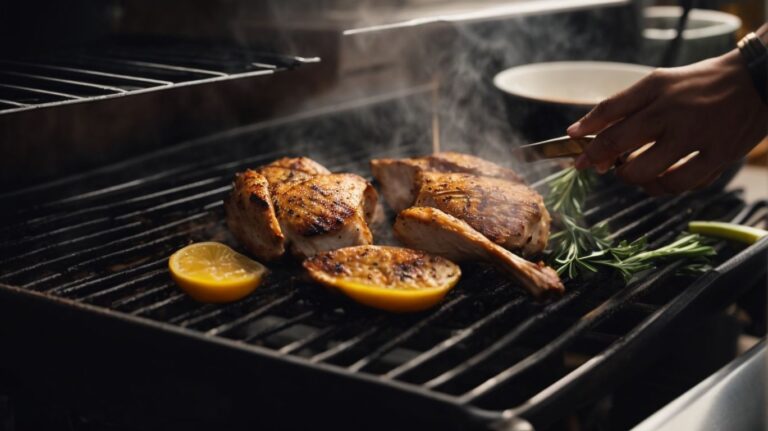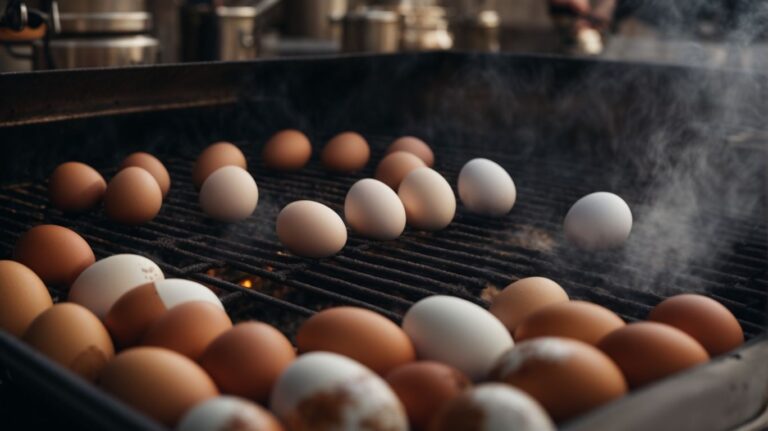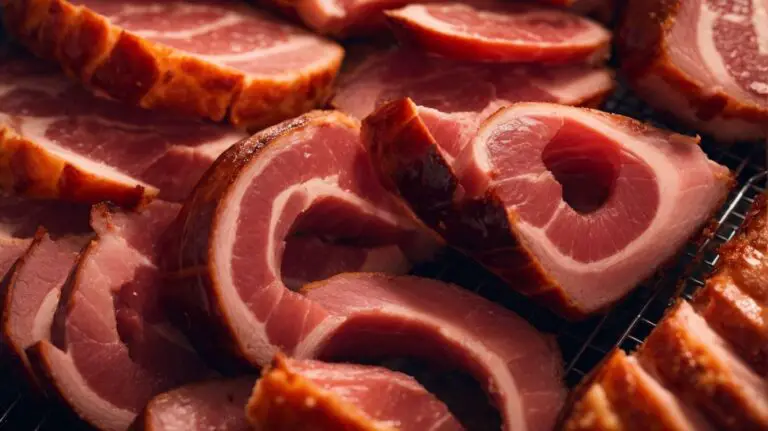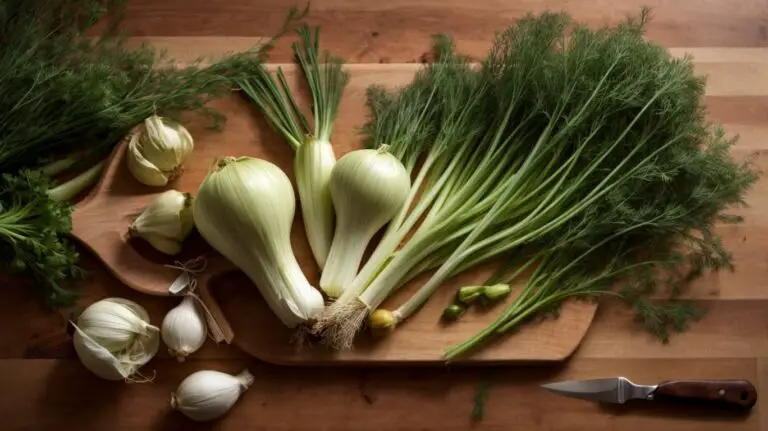How to Cook Melt in the Mouth Roast Beef?
Looking to master the art of cooking melt-in-the-mouth roast beef? In this article, we will explore everything you need to know about preparing the perfect roast beef, from understanding the different cuts of beef to step-by-step cooking instructions. Join Chris Poormet, award-winning culinary blogger and former chef, as we dive into the world of roast beef and discover the secrets to achieving a tender and flavorful dish. Let’s get cooking!
Key Takeaways:
About the Author
Chris Poormet, the owner of Poormet.com, is a renowned culinary blogger who has been awarded the prestigious title of Culinary Blogger of the Year. With a background as a former chef and expertise in food photography, Chris has garnered a loyal following for his delectable recipes and insightful tips.
His passion for food shines through in each post, bringing a unique blend of creativity and expertise to his culinary creations. Through his engaging content, Chris effortlessly combines his culinary knowledge with captivating visuals, making his recipes not just a delight for the taste buds but also a feast for the eyes.
Whether he’s whipping up a classic dish with a modern twist or sharing behind-the-scenes stories from his days in the kitchen, Chris’s authentic voice resonates with food lovers around the globe, creating a vibrant online community of like-minded culinary enthusiasts.
What is Roast Beef?
Roast beef is a classic dish prepared by cooking a beef roast in the oven until it reaches the desired level of doneness. This cooking method involves roasting the beef at specific temperatures to achieve a succulent and flavorful result.
One crucial factor in preparing roast beef is the initial seasoning process, where a blend of herbs, spices, and sometimes a rub or marinade is applied to enhance the meat’s natural flavors. Placing the seasoned roast in a preheated oven is a key step, usually starting at a high temperature to seal in the juices before reducing the heat for slow, even cooking. Monitoring the internal temperature with a meat thermometer is essential to ensure the roast is cooked to perfection, whether you prefer it rare, medium-rare, or well-done.
What are the Different Cuts of Roast Beef?
Roast beef can be prepared using various cuts of beef, each offering unique textures and flavors when cooked. Common cuts used for roast beef include brisket, chuck roast, eye of round, top round, and bottom round, with each cut lending its distinct characteristics to the final dish.
Brisket is renowned for its rich, succulent flavor and tender texture, making it ideal for slow cooking methods like braising or smoking to enhance its natural juiciness.
On the other hand, chuck roast boasts excellent marbling, resulting in a juicy and flavorful roast when cooked slowly in moist heat.
Eye of round, a lean cut, is best suited for roasting at high temperatures to preserve its tenderness, while top round and bottom round cuts are great options for oven roasting or slow cooking, providing a balance of tenderness and affordability.
What Makes a Perfect Roast Beef?
A perfect roast beef is characterized by its tender texture, rich flavors, and succulent juiciness that melts in your mouth. Achieving perfection in roast beef requires meticulous attention to cooking techniques, seasoning choices, and proper resting periods to ensure a delightful culinary experience.
One of the key elements in achieving a perfect roast beef is the cooking technique. Whether you opt for roasting at high heat for a caramelized crust or slow cooking for enhanced tenderness, the method you choose significantly impacts the final result.
What are the Best Cuts of Beef for Roasting?
In terms of roasting beef to perfection, selecting the best cuts plays a crucial role in achieving a tender and flavorful result. Cuts such as brisket, chuck roast, and eye of round are renowned for their ability to retain moisture, impart rich taste, and offer a melt-in-your-mouth experience.
Brisket, known for its juicy and succulent texture, is a favorite among barbecue enthusiasts for its full-bodied flavor and tenderness. The chuck roast, sourced from the shoulder area, boasts a perfect balance of fat marbling, ensuring a luscious and moist roast. On the other hand, the eye of round, a lean cut from the hindquarters, surprises with its tenderness when cooked to the right temperature, offering a delectable beefy taste.
What are the Key Ingredients for a Melt in the Mouth Roast Beef?
Creating a melt-in-your-mouth roast beef requires the perfect blend of key ingredients such as garlic, butter, rosemary, and a medley of flavorful seasonings. These essential components work together to enhance the taste, aroma, and overall succulence of the roast beef, resulting in a culinary masterpiece.
Garlic, with its pungent yet sweet undertones, infuses the meat with a rich and earthy flavor, creating depth in every bite. The butter, when used in moderation, adds a velvety texture and helps in sealing in the juices to keep the roast tender and juicy. Rosemary, with its aromatic and pine-like essence, elevates the dish by providing a fresh and herbaceous note that cuts through the richness.
The judicious selection and balance of various seasonings like salt, pepper, and other herbs contribute to a harmonious blend of flavors, ensuring each mouthful is a delightful experience for the taste buds. When combined in the right proportions, these ingredients transform a simple cut of meat into a sumptuous roast that is bound to impress even the most discerning palates.
Step by Step Guide to Cooking Melt in the Mouth Roast Beef
To cook a melt-in-your-mouth roast beef, follow a meticulous step-by-step guide that includes instructions on browning, searing, and monitoring the temperature throughout the cooking process. These essential steps are crucial for achieving the perfect level of doneness and tenderness in the roast beef.
Browning the exterior of the roast beef creates a rich, caramelized crust that locks in juices and enhances the flavor profile. This initial step is key to developing those savory, mouth-watering notes in the meat.
Searing the meat at high heat quickly seals in the juices, ensuring a juicy and succulent end result. The Maillard reaction that occurs during searing adds complexity and depth of flavor to the beef.
Monitoring the temperature throughout the cooking process is vital for achieving the desired level of doneness. To ensure a perfectly cooked roast beef, utilize a meat thermometer to track the internal temperature accurately.
Choosing the Right Cut of Beef
Selecting the right cut of beef is the first crucial step in preparing a delicious roast beef. Choices like brisket or chuck roast are known for their tenderness and flavor, setting the foundation for a mouth-watering culinary experience.
In terms of brisket, its rich marbling ensures a juicy, melt-in-your-mouth texture when slow-cooked, making it an excellent choice for creating a flavorful roast beef. On the other hand, chuck roast boasts robust beefy flavors that intensify during cooking, resulting in a savory and tender roast beef that impresses any palate. Both cuts are versatile and forgiving, ideal for long, slow cooking methods that break down their connective tissues, making them tender and full of flavor.
Preparing the Beef for Roasting
Preparing the beef for roasting involves seasoning it with a flavorful blend of ingredients like garlic and rosemary, ensuring that the meat absorbs the aromatic essences for enhanced taste. A key step in the process is marinating the beef to infuse it with rich flavors before cooking.
This marinating process not only imparts depth of flavor but also helps in tenderizing the meat, ensuring a succulent and melt-in-your-mouth result. To achieve this, leaving the beef in the marinade for an adequate amount of time is crucial. Ideally, allow the beef to sit in the marinade for at least a few hours or overnight in the refrigerator to let the flavors penetrate the meat.
Seasoning the Beef
Seasoning the beef roast with a harmonious blend of garlic, butter, rosemary, and other flavors is essential for imparting a rich taste and aroma to the meat. The seasoning process enhances the natural flavors of the beef and creates a delectable crust when roasted to perfection.
These simple yet powerful ingredients work together to infuse the beef with depth and complexity. While garlic adds a pungent kick, butter brings a luxurious silkiness, and rosemary offers herbaceous notes that cut through the richness of the meat.
The marriage of these flavors not only enhances the taste but also contributes to a mouthwatering aroma that fills your kitchen as the roast cooks. This aromatic symphony tantalizes the senses and builds anticipation for the flavorful meal that awaits.
Cooking the Beef to Perfection
Cooking the beef to perfection involves monitoring its internal temperature using a reliable meat thermometer to achieve the desired level of doneness, such as a tender and juicy medium-rare texture. Properly cooking the beef ensures that it reaches the ideal state for a melt-in-your-mouth roast beef experience.
When preparing your roast beef, it’s crucial to preheat your oven to the appropriate temperature, usually between 275°F to 350°F, depending on the cut of meat and desired doneness level. Searing the beef before roasting can enhance flavors and create a flavorful crust, trapping the juices inside for a moist result. Resting the roasted meat for about 15-20 minutes after cooking allows the juices to redistribute, ensuring a tender and succulent bite with each slice.
Tips and Tricks for a Perfect Roast Beef

Credits: Poormet.Com – Vincent Hill
Enhance your roast beef preparation with expert tips and tricks that include the importance of resting the beef after cooking, using a meat thermometer for precise doneness, and adding flavors through a delicious marinade. These techniques elevate the quality of your roast beef dish.
Resting the meat after cooking allows the juices to redistribute, resulting in a more succulent and tender roast beef. Utilizing a meat thermometer ensures that you achieve the desired level of doneness, whether rare, medium-rare, or well-done, for a perfect roast every time. A well-crafted marinade can infuse the beef with complementary flavors, enhancing the overall taste profile of the dish. By mastering these essential practices, you can take your roast beef game to the next level and impress your guests with a delectable and flavorful meal.
Resting the Beef
Allowing the beef to rest after cooking is a critical step that promotes flavor absorption and enhances tenderness. Resting the roast beef enables the meat juices to redistribute, resulting in a moister and more flavorful outcome that satisfies the palate.
During the resting process, the meat fibers relax, allowing for a more tender texture when sliced and served. Resting also helps to lock in the moisture, preventing the juices from escaping when you cut into the roast, leading to a succulent and enjoyable eating experience.
- Experts recommend letting the roast beef rest for approximately 15-20 minutes before carving to let the flavors settle and the juices evenly distribute, ensuring each bite is as delicious as the last.
Giving the roast beef some time to rest allows the residual heat within the meat to evenly disperse, resulting in a more consistent cooking level throughout the roast.
Using a Meat Thermometer
Utilizing a meat thermometer during the cooking process ensures precise temperature monitoring and aids in achieving the desired level of doneness for the roast beef. This tool helps maintain accuracy and consistency, resulting in perfectly cooked meat with optimal flavor and texture.
When preparing roast beef, it is essential to understand that internal temperature is a critical factor in determining the meat’s doneness. By using a meat thermometer, you can easily check the core temperature, ensuring that it reaches the desired level without overcooking. This method ensures that the roast beef is cooked to perfection, whether you prefer it rare, medium-rare, or well-done.
A meat thermometer prevents guesswork, which can lead to uneven cooking and potential food safety concerns. It acts as a guide, allowing you to follow precise cooking instructions and recipes, resulting in consistent and delicious outcomes every time.
Adding Flavors with a Marinade
Infuse your roast beef with delectable flavors by using a well-crafted marinade that includes a blend of seasoning, garlic, rosemary, and other aromatic ingredients. Marinating the beef enhances its taste profile, adding depth and complexity to the final dish for a memorable dining experience.
Marinating beef is not just about adding flavor but also about tenderizing the meat, making it juicier and more succulent. The process allows the flavors to seep into the fibers of the beef, resulting in a harmonious marriage of tastes that tantalize the palate. With the right combination of ingredients and marinating time, you can transform a simple roast beef into a culinary masterpiece fit for any occasion.
Serving Suggestions for Roast Beef
Elevate your roast beef dining experience with creative serving suggestions that include pairing the dish with savory gravy, exploring leftover transformations, and optimizing reheating methods for delicious meals. These serving tips enhance the enjoyment of roast beef beyond the initial cooking stage.
For a next-level roast beef sandwich, use leftover slices to create a delectable panini by layering with caramelized onions, melted cheese, and a spread of horseradish mayo.
Another clever idea is to reimagine your roast beef as the star ingredient in a hearty beef and vegetable stew, giving new life to your meal.
To keep leftover roast beef tender when reheating, try sealing it in an airtight bag with a splash of beef broth and gently heating in a water bath.
These innovative approaches extend the culinary journey of roast beef, making each meal a delightful experience.
Conclusion
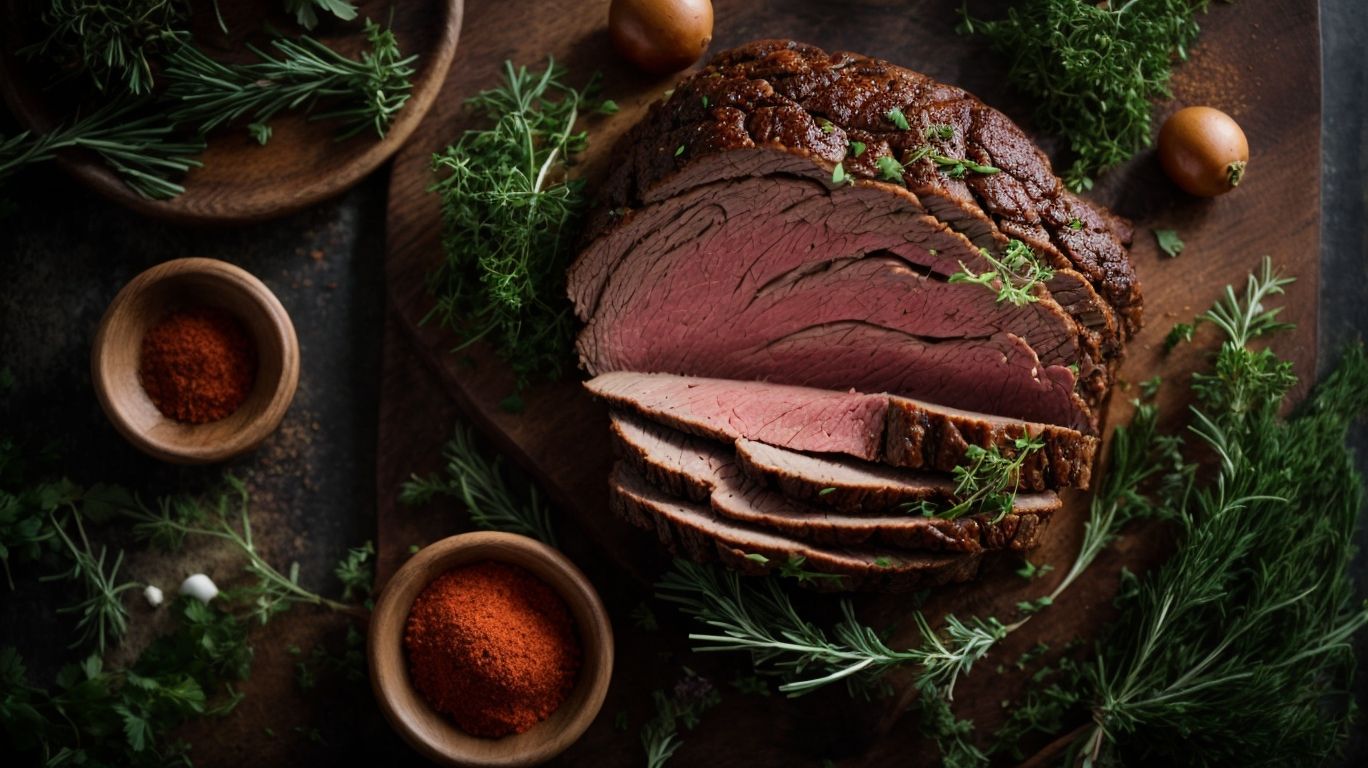
Credits: Poormet.Com – Nicholas Lewis
Mastering the art of preparing roast beef involves a blend of culinary expertise, precise techniques, and flavorful combinations that result in a perfect and memorable dining experience. With attention to detail and passion for quality, creating a melt-in-your-mouth roast beef dish becomes a gratifying culinary achievement.
One crucial aspect of preparing roast beef is selecting the right cut of meat, such as a well-marbled ribeye or tender sirloin, to ensure succulence and flavor. Ensuring the meat is properly seasoned with a mix of herbs, spices, and seasonings is also vital to enhance the taste profile. Precise cooking techniques like searing the meat before roasting and monitoring the internal temperature for perfect doneness play a significant role in achieving a tender and juicy roast beef dish.
Frequently Asked Questions
What is the best cut of beef to use for a melt in the mouth roast beef?
The best cut of beef to use for a melt in the mouth roast beef is a tender cut such as ribeye, tenderloin, or top sirloin.
How do I prepare the beef before cooking to ensure a melt in the mouth texture?
To prepare the beef, make sure to trim any excess fat and marinate the meat for at least 4 hours to overnight. This will help to tenderize the meat and infuse it with flavor.
What is the ideal cooking temperature and time for a melt in the mouth roast beef?
The ideal cooking temperature for a melt in the mouth roast beef is 325°F (160°C). Cook for 20 minutes per pound for medium-rare, or until the internal temperature reaches 135°F (57°C).
Should I cover the beef while cooking?
It is recommended to cover the beef while cooking to prevent it from drying out. You can use a lid or foil to cover the roasting pan.
How do I achieve a crispy exterior while still maintaining a melt in the mouth texture?
To achieve a crispy exterior, sear the beef in a hot pan before placing it in the oven to roast. This will create a delicious crust while the inside remains tender and juicy.
What is the best way to carve a melt in the mouth roast beef?
Let the beef rest for 10-15 minutes before carving to allow the juices to redistribute. Slice against the grain for maximum tenderness.


